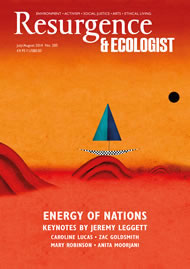I have been watching MasterChef again. And it shows. So instead of offering a jelly and an ice cream made from gorse flowers, I am presenting Textures of Gorse, showcasing, primarily, the scent of this coastal scrubland flower.
‘Scrubland’ is probably a bit harsh – but then so are the lethal-looking spikes that protect the bright yellow florets that you are going to have to pluck carefully – one, painstakingly, at a time – in order to produce an intensely heady flavour to your ice cream unlike anything else I have ever tasted.
A powerful infusion that smells somewhere between coconut and almond on the gorse bush, it was this wafting scent of the flowers – more than their colour or taste – that I had wanted to capture, so the fact that the ice cream is not only deeply fragrant but delicious too proved an unexpectedly joyous bonus!
In true MasterChef style I served my gorse dessert dish as a Quenelle of Gorse Petal Ice Cream with A Trinity of Gorse Jelly Cubes (three) and a dark slice of sinful warm and sticky Spiced Date Cake.
My botanist husband took up his dessertspoon with what looked to me like trepidation, but after a long and somewhat alarming silence he produced one of those one-word sound bites so beloved of primetime TV: “Showstopper,” he declared.
And I agree.
This is Jelly & Ice Cream for the Grown-ups, who, just like the children, will definitely want more, please!
Vitality notes
If you are lucky enough to see gorse cheerfully flowering on old wastelands, you will have seen for yourself that it is one of those uplifting plants that can thrive where others may very well give up. And it is this ‘optimism’ that naturopaths and others who work with natural remedies harness in prescribing a gorse-flower essence or homeopathic pill for those who have lost all hope. This is the remedy to reignite faith and the conviction that good things lie ahead.
Harvesting the flowers
With gorse flowers, it’s more a case of slow plucking than snappy picking, and you will need to be very, very patient. Actually, rush if you like, but you will pay the price with lots of nasty spikes and pricks from the sharp spines that give gorse its natural protection from predators (and if you have set out to forage and thus incidentally steal the pollen, this means you!).
If the flowers are going to be on show, as they are in the top of the jelly, what works best for me is to carefully pluck the largest heart-shaped petal on each flower and set this aside ‘for best’. I am reliably informed this is known as the standard petal. It works like an umbrella to protect the pollen from rain. For you and me, it just means the big one. You can then return to each spiny branch to nip off the remainder of the flowers for the ice cream.
Check, as you pluck, for tiny white maggots with little black heads – very cute, but probably not if appearing as frozen specimens in your pudding dish – and for other roaming insects. Relocate Jain-style to somewhere more suitable than your freezer/fridge.
Into the kitchen
Golden Gorse Petal Scented Ice Cream
Ingredients
• 2 generous handfuls of gorse flowers
• 150ml milk
• 2 medium-sized egg yolks
• 150g caster sugar
• a pinch of sea salt
• 200ml double cream
Method: Easy!
Soak your gorse flowers in the milk and leave overnight in the fridge so that the coconutty/almondy/not-like-anything-else-really gorse scent and flavour can thoroughly infuse the liquid.
When you are ready to make your ice cream, beat the egg yolks with the sugar. Tip the infused milk and flowers into a saucepan and bring slowly almost to the boil. Add to the bowl of beaten egg yolks and sugar, stirring to dissolve the sugar granules. Add a pinch of salt and then sieve the mix to remove and discard the gorse flowers. Leave to cool, add the cream and stir.
If you have an ice-cream maker, follow the manufacturer’s instructions from now on. If not, pour your mix into a freezer-proof container (how about an old ice-cream carton?) and freeze.
Check the ice-cream mix on the hour, every hour, and beat it each time to prevent crystals from forming. Stop once it looks – and tastes – like ice cream. (My mix took about four hours to freeze properly, and worked a treat. The only thing I found hard was resisting the temptation to open the door every five minutes because patience, as it turns out, is not my middle name.)
Next time I plan to use clotted cream instead of double cream, and golden caster sugar, which I think/hope might change the resultant ice cream from a pale, pale chiffony yellow to a more intense lemon colour. But that’s the joy of cooking with wild foods: you never know until you try it…
Gorse Jelly Cubes
I admit I panicked the first time I made this, and because it was hard to judge whether the syrup was going to set, I used far too much gelatine. This was a shame, because it made for a very dense jelly. Stick with the two sachets, and you should get just the right wibbly-wobbly consistency.
Ingredients
• 2 generous handfuls of gorse flowers – reserve a small pile of the more pristine petals for show
• 1 litre cold water
• 3 tbsp caster sugar
• 1 tbsp lemon juice
• 2 sachets of vegetarian gelatine
Method: Very Easy!
Make a gorse-flavoured syrup by putting your gorse flowers in a saucepan along with the water, sugar and lemon juice. Bring to the boil, stirring continuously. When all the sugar has dissolved, remove the pan from the heat and leave the flowers to steep. When it has cooled, sieve the syrup to remove the flowers.
Return the syrup to the heat and add the gelatine. Bring slowly to the boil again, and boil for 2 minutes.
Remove from the heat and allow to cool enough to pour into a mould (I use a loaf tin).
Just before you pour, layer the pristine petals you picked first in the bottom of the mould. These are purely for decoration and will look great when you serve your Textures of Gorse finished dish.
When the jelly has set (2–4 hours), slice (or cube) it to serve with your gorse ice cream.








